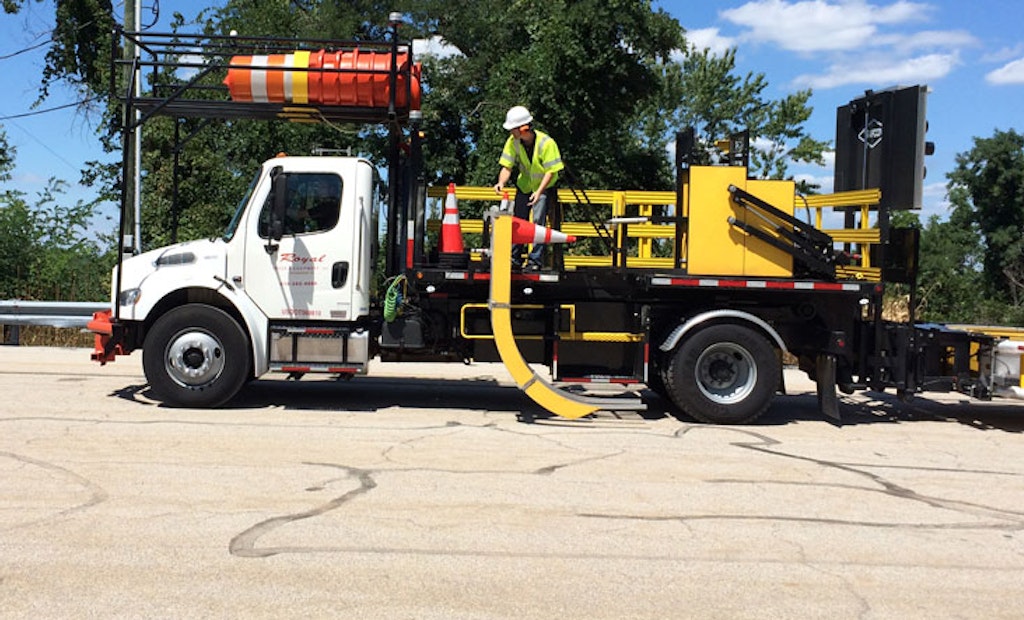Interested in Safety?
Get Safety articles, news and videos right in your inbox! Sign up now.
Safety + Get AlertsA lonely highway winds through a mountain pass. Two workers in a safety cone truck slowly navigate the curves, placing safety cones to direct traffic around a construction zone. The driver focuses on road safety. It’s a treacherous route with tight turns that require his full attention. A lapel mic for a two-way radio connects him to another worker in the rear position. The rear worker also has a two-way radio strapped to his belt and a lapel mic attached to his chest.
Suddenly, the driver swerves.
To the driver, the maneuver is barely noticeable — he just wanted to avoid a pothole. The radio is quiet. No complaints from the rear worker. He keeps his eyes on the road and continues.
Meanwhile, the swerve has thrown the rear worker off the truck. The fall tears the radio from his hip and crushes it on the road. As he rolls, injured, he watches the truck disappear around the corner, continuing down the mountain.
This is a true story. A few miles later, the driver realized that the rear worker was gone. He retraced his route and found his colleague injured on the side of the road. The injuries weren’t fatal, but the worker was unable to return to the job.
WHEN 2-WAY RADIOS FAIL
When the DOT’s safety committee investigated the incident, they discovered three road safety drawbacks to using two-way radios on a cone truck:
- The driver couldn’t safely take a hand off the wheel, key his PTT and notify the rear position about the swerve in time to prevent the accident.
- The rear position shouted, but because he didn’t have time to engage PTT, the driver did not hear him.
- The inability to communicate as if they were sitting together in the cab of the truck limited their situational awareness.
6 WAYS TO PROTECT DOT CREWS
Based on our discussions with DOT safety committees and maintenance managers whose crews use Sonetics team communication systems, we narrowed down six ways wireless headsets protect DOT road crews:
- Hear each other in high noise. With two-way radio lapel mics crushed against your shoulder it’s difficult to hear and be heard over loud equipment and traffic.
- Hear everyone on the system all the time. Because of the wait-your-turn technology of two-way radios, when someone dominates the conversation, no one else can get a word in, even if it’s a warning shout.
- Free up machine operators’ hands so they can remain on the controls. Provide an instant acknowledgement of instructions. With Sonetics, you just talk. No PTT. No waiting your turn.
- Control the amount of ambient noise to sharpen situational awareness. Flaggers need to hear cars and typically don’t feel safe with their ears covered. Sonetics Listen-Through technology lets flaggers communicate with the team and hear all the traffic around them, all while protecting their hearing. Machine operators use Listen-Through technology to boost noise canceling and improve concentration.
- Provide detailed instructions. When you’re not battling to communicate, you can pay more attention to detail and work more confidently.
- Hear yourself on the job and at home. Improve morale on the job, and eliminate the ringing in your ears when you’re trying to relax at home after a long day of working around loud machinery.
Personal road safety provides the peace of mind your DOT road crews need to be more productive, whether on remote mountain roads or clogged inner city intersections. According to Steven Montpas, Oregon Department of Transportation field technician, “Sonetics wireless headsets help us increase productivity, reduce accidents and lower stress levels by allowing our teams to communicate more effectively on the job.”
Sonetics wireless headsets are ideal for working around asphalt grinders, milling machines, painting and cone trucks, sweepers operating at night … basically for any situation where fellow crew members are beyond the line of sight but need to stay in continuous communication.







